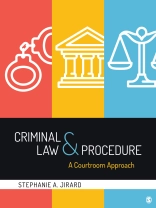Written by a former federal prosecutor and public defender, Criminal Law and Procedure: A Courtroom Approach introduces students to the essentials of criminal law and procedure by illuminating the legal issues justice professionals face before, during, and after a criminal trial. Through the examination of statutes, edited case excerpts, and recent constitutional interpretation of black letter law, the text bridges the gap between learning criminal procedure and applying criminal law.
Drawing from author Stephanie A. Jirard’s vast experience in both the courtroom and the classroom, Criminal Law and Procedure gets students to think critically about real-world issues and practice applying the law in a just and meaningful way. Accessible and engaging, this text presents criminal law and procedure as an exciting opportunity to have a direct, positive impact on our communities and the criminal justice system.
Key Features:
- ‘Making the Courtroom Connection’ boxes help students apply the legal concepts they learn to real-life issues facing law enforcement, the court system, and correctional institutions today.
- Edited case excerpts connect criminal law and procedure with current case material on relevant topics so students can see the impact of judicial decision making.
- ‘Applying the Law to the Facts’ boxes engage students’ critical thinking skills and enhance their logical problem-solving abilities by providing opportunities to apply the rule of law to different scenarios.
- ‘Springboard for Discussion’ prompts spark conversations and invite students to contrast the moral, ethical, and legal implications of criminal law and procedure in a larger context.
- Problem-solving exercises at the end of each chapter provide students with opportunities to test themselves on the material before a formal assessment.
- Active Learning Exercises in the Instructor’s Manual enable professors to offer additional opportunities for experiential learning.
Give your students the SAGE edge!
SAGE edge offers a robust online environment featuring an impressive array of free tools and resources for review, study, and further exploration, keeping both instructors and students on the cutting edge of teaching and learning.
İçerik tablosu
Preface
Acknowledgments
About the Author
PART I. THE BASICS: HOW THE LAW WORKS
CHAPTER 1. Introduction to the Law
Learning Objectives
Sources of Criminal Law
How to Read Statutes and Case Briefs
The Geography of Legal Cases
The Actors in the Criminal Justice System
Protecting Citizens and Criminal Justice Professionals
Federalism and States’ Rights
Summary
Key Terms and Phrases
Problem-Solving Exercises
CHAPTER 2. THE CRIMINAL TRIAL PROCESS
Learning Objectives
Pretrial Identification Procedures
The Adversary System
Trial
How a Case Gets to the U.S. Supreme Court
Summary
Key Terms and Phrases
Problem-Solving Exercises
CHAPTER 3. CRIMINAL LAW BASICS
Learning Objectives
Mens Rea: The Guilty Mind
Actus Reus: The Guilty Act
Causation
Parties to Crime
Inchoate Crimes
Summary
Key Terms and Phrases
Problem-Solving Exercises
PART II. THE CRIMES: CRIMINAL LAW ELEMENTS
CHAPTER 4. CRIMES AGAINST THE PERSON
Learning Objectives
Crimes Against the Person
Sex Offenses
Homicide
Robbery
Summary
Key Terms and Phrases
Problem-Solving Exercises
CHAPTER 5. CRIMES AGAINST PROPERTY
Learning Objectives
Theft Crimes
White-Collar Crime
Burglary
Arson
Summary
Key Terms and Phrases
Problem-Solving Exercises
CHAPTER 6. CRIMES AGAINST THE PUBLIC
Learning Objectives
Crimes Against the Public
Crimes That Interfere With Government Services
Computer Crimes
Terrorism
Treason
Summary
Key Terms and Phrases
Problem-Solving Exercises
PART III. THE PROCEDURE: THE BILL OF RIGHTS
CHAPTER 7. THE FOURTH AMENDMENT AND WARRANTS
Learning Objectives
The Fourth Amendment
Seizures of the Person
The Warrant Requirement
Summary
Key Terms and Phrases
Problem-Solving Exercises
CHAPTER 8. EXCEPTIONS TO THE WARRANT REQUIREMENT
Learning Objectives
Warrantless Searches and Seizures
The Exclusionary Rule and the Good Faith Exception
Summary
Key Terms and Phrases
Problem-Solving Exercises
CHAPTER 9. THE FIFTH AMENDMENT AND CONFESSIONS
Learning Objectives
The Evolution of Miranda Warnings
Invoking the Rights Pursuant to Miranda
When Miranda is Violated
Summary
Key Terms and Phrases
Problem-Solving Exercises
CHAPTER 10. THE SIXTH AMENDMENT: COUNSEL AND TRIAL RIGHTS
Learning Objectives
The Sixth Amendment as Due Process Protection
Invoking the Right to Counsel
The Criminal Case
Summary
Key Terms and Phrases
Problem-Solving Exercises
PART IV. THE PERSONAL: OFFENDER-SPECIFIC PUNISHMENT
CHAPTER 11. THE FIRST AMENDMENT AND CRIMINAL LAW
Learning Objectives
Protected Speech
Unprotected Speech
Special First Amendment Issues
Freedom of Association
Freedom of Religion
Summary
Key Terms and Phrases
Problem-Solving Exercises
CHAPTER 12. DEFENSES
Learning Objectives
How Defenses Are Raised
Competency
Defenses Based on Excuse
Defenses Based on Justification
Summary
Key Terms and Phrases
Problem-Solving Exercises
CHAPTER 13. SENTENCING AND APPEALS
Learning Objectives
Sentencing Process
Types of Sentences
The Death Penalty
The Appellate Process
Summary
Key Terms and Phrases
Problem-Solving Exercises
Appendix A: The Constitution of the United States of America
Appendix B: Selected Excerpts From the Model Penal Code
Glossary
Notes
Case Index
Subject Index
Yazar hakkında
A Massachusetts native, Stephanie A. Jirard is a Professor of Criminal Justice at Shippensburg University in Pennsylvania. She received her A.B. in History from Cornell University, her J.D. from Boston College Law School, and her M.A. in Applied History at Shippensburg. She is a former Lieutenant in the United States Navy’s Judge Advocate General (JAG) Corps, where she defended sailors and Marines at courts-martial across the state of Louisiana. At the Navy’s personnel headquarters in Washington, D.C, Jirard provided legal counsel in family and child sexual abuse matters. After leaving the Navy, Jirard was a Trial Attorney at the United States Department of Justice, Civil Division, Torts Branch, defending the federal government across the country in environmental and human radiation experiment lawsuits. She also served as an Assistant United States Attorney and an Assistant Federal Public Defender, both in the District of Massachusetts. Jirard’s last litigation post was serving as an Assistant State Public Defender in the Capital Litigation Unit in Columbia, Missouri, representing men in death-penalty cases. Jirard has published on race and politics, the Civil War’s U.S. Colored Troops, missing women, cyberbullying, and sex scandals. This is her second textbook on Criminal Law and Procedure.












